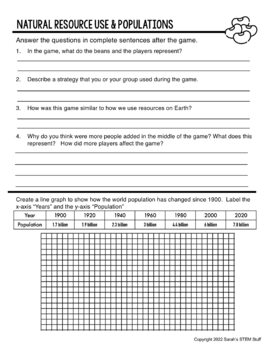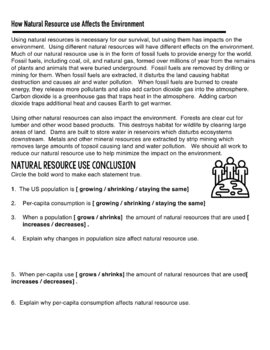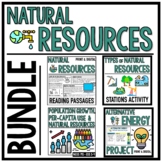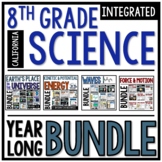Natural Resources and Population Growth: Graphs and Game - MS-ESS3-4
- PDF
What educators are saying
Also included in
- This bundle focuses on natural resources and how their use affects Earth. Students start by learning the difference between nonrenewable and renewable resources and examples of each. Then students model the mining process by mining for chocolate chips and seeing how extracting resources affects thPrice $15.20Original Price $19.00Save $3.80
- Teaching is hard! Make things easier with this bundle that has everything you need for the full year. This year long bundle includes everything you need to teach a middle school level course that meets the NGSS 8th Grade integrated standards for California. This bundle contains a variety of engagiPrice $185.00Original Price $252.50Save $67.50
Description
Help students connect population growth and per capita consumption to natural resource use. Students begin the lesson with a fun interactive game that teaches students about responsible natural resource use and how individual use and population growth affect the use of natural resources. After playing the game, students read short reading passages and analyze graphs to see how the human population is changing and how per capita energy use is changing. Based on these readings and graphs, students finish the lesson with a conclusion that focuses on the
NGSS Standard:
MS-ESS3-4. Construct an argument supported by evidence for how increases in human population and per-capita consumption of natural
resources impact Earth's systems.
Part 1: Natural Resource use Game & Questions – In this activity focuses on renewable natural resources and students can see how overuse can lead to the depletion of renewable resources
Part 2: Graphing Population Growth + Reading and Questions – Students graph the US population from 1900 – 2020 to see how it has changed over time.
Part 3: Connecting population growth and per-capita use to natural resource use
Students read the short sections and then answer questions to see how population growth and per capita use affect the use of natural resources.
Part 4: Analyzing Graphs. The 4 graphs and questions are on separate pages. To save on color printing, do this section in groups and print one set of graphs for each group and laminate them to use year after year. You can also project each graph and the whole class can view one at a time while it is projected if you do not have access to color printing.
Part 5: The effects of natural resource use on Earth – students read this section to see how natural resource use affects the environment.
Part 6: Conclusion – after completing all sections, students complete the conclusion to put everything together.







